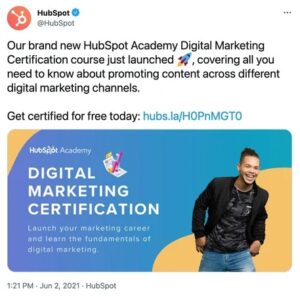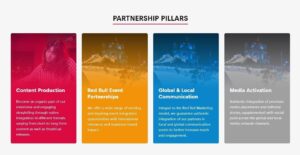It’s a simple equation: more leads = more business. Except it’s not really all that simple. It’s more like this: (the right leads + the right messaging + the optimal channel/cost per acquisition = revenue) x infinity = growth.
Have we lost you yet?
Okay, we’re not exactly math whizzes, but we do know that growing and converting leads can be a major headache for brands. In fact, it’s their number one complaint:
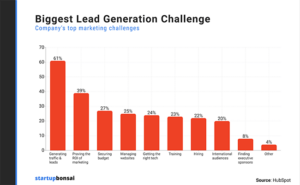
Fortunately, we’ve got some tried-and-true tips on bringing in more leads (and turning them into conversions) that will help you achieve long-term, sustainable growth
What’s an Inbound Lead?
To better understand what an inbound lead is, let’s first look at what inbound lead generation is.
Inbound lead generation is a powerful marketing strategy involving attracting prospects, called leads, to your brand. It’s the opposite of outbound lead generation, which involves reaching out to customers.
The most significant difference between inbound lead generation and outbound lead generation is that inbound lead generation is permissive, meaning your prospects initiate the conversation. On the other hand, outbound lead generation is invasive, meaning you have to disrupt a user’s experience to get their attention.
For your inbound lead generation strategy to work, you must create valuable content that moves your ideal customer to interact with your brand.
So, what is an inbound lead?
An inbound lead is a website visitor that interacts with your marketing assets or web pages and submits their contact information.
Effectively, any lead coming through your pipeline voluntarily is classified as an inbound lead. However, despite coming into your pipeline the same way, not all inbound leads are equal. There are 2 types of inbound leads you should expect to see moving through your buyer journey:
- Marketing qualified leads (MQLs): These are inbound leads that have expressed interest in your content and your product offer but are not ready to buy.
- Sales qualified leads (SQLs): SQLs are inbound leads that have passed the curiosity stage and are actively looking for a solution.
Knowing the difference between the 2 will help you get the best results out of your inbound lead generation strategy. As a result, you’ll be better able to convert MQLs into SQLs and SQLs into paying customers.
How Leads Are Generated
Before we get started, you need to understand how leads are generated. First, visitors click on a call-to-action (CTA) image, button, message, etc., to encourage them to take action. The CTA takes them to a landing page that captures their information in exchange for something of value to them. The visitor then fills out a form to receive your offer.
Sounds simple enough, but there are tips and tools to utilize to ensure you’re getting qualified leads. Curious to know more about lead generation? Our lead gen specialist shares need-to-know info in our “9 Best Pieces of Advice from Your Neighborhood Lead Generation Specialist” blog.
Step 1: Use Dedicated Landing Pages for Each CTA
Landing pages are crucial for conversion. The information you gather and the page you send your visitors to can turn a prospect into a customer. If offering a special download, visitors should be sent to a landing page relevant to the download, not a home page or contact us page. If you have a variety of offers, then there should be multiple landing pages visitors are sent to.
Not only will this create a high-converting landing page, but it will keep you organized on the backend with which leads to go after based on which form they completed. In this blog, we share landing page best practices to follow.
Step 2: Create Different Offers for Each Phase of the Buyer’s Journey
Visitors can range from being at the beginning of their buyer’s journey to being at the end, and depending on where they are in their journey is the type of offerings they should be receiving. Your CTAs should focus on broad offerings to make sure there is something for everyone regardless of where they are in their journey.
Examples of offers for someone at the beginning of the buyer’s journey include ebooks, whitepapers, and guides. Offers for the end of the buyer’s journey could include free trials or demos.
You can take this one step further if you funnel your leads by where they are in their buyer’s journey. You can send targeted offers that relate to the respective part of the buying journey the visitor is in.
Step 3: Keep the Messaging Consistent
Whether it’s the landing page, email, CTA, blog, or social media post, keeping the messaging the same is important when providing value to prospective customers. If they see different messaging or different offers, they may become confused and be difficult to convert to a lead.
Step 4: Get Social With It
When it comes to how to get leads for your business, social media shouldn’t be forgotten about. We know the power of social media changes what seems daily, and there’s always a new “best” way to use it to achieve your goals.
To get new business leads, you need to do more than just post frequently on social media. When crafting your social media post, use links in your captions that go directly to your landing pages that include your high-performing offers. You can also send them to high-performing blogs that generate the most leads for you.
Your brand’s presence on social media has never been more important than it is now. But thanks to shifting algorithms and privacy settings, you can no longer rely on organic reach alone to connect you to the right audience.
You can run specific lead generation ads on almost all the leading social networks on a modest budget. In fact, social media is now the fastest-growing medium for ad spend and is predicted to overtake television ad spend for the first time ever.
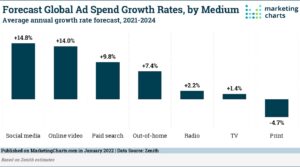
Facebook and Instagram, for instance, offer lead generation ads specifically designed for brands interested in generating business leads. Boosting a post for more engagements or running an ad for more followers isn’t a good idea.
If you need leads, run lead generation ad campaigns on your preferred social media network (based on buyer persona).
Step 5: Let Your Customers Do the Talking
Many qualified leads often come from current, happy customers. What’s more credible than a satisfied customer referring you? Sometimes customers may refer you naturally, and other times they need to be nudged to do some referring.
When closing your sale, try to include an incentive if your customer refers you. An example could be to offer 10% off their next project with you and 10% off the referral’s first project with you. Additionally, ask your customers to leave you a testimonial. Reviews speak volumes and are simple and easy lead generators.
Here are a few ideas on how to offer incentives:
- Offer an incentive to the company referring you.
- Offer an incentive to both the company and referral for a discount on their next project.
- Offer an incentive to the referral.
- Ask current customers to leave testimonials and product reviews for you — share those testimonials on your website and/or product pages if it’s product specific.
Step 6: Make It Personal
When you get an email addressed personally to you, how does it make you feel? We’re guessing the fact that the brand took an extra step to personalize the email to you makes you feel good and like you’re being directly spoken to.
So why not make your customers feel the same way? It’s a simple task to complete and can help you gain new business leads. Whichever email platform you use, personalize your emails to include the recipient’s name. It will look like this:
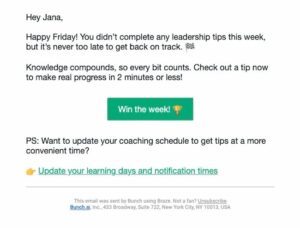
This small touch will generate new business leads for you and make your potential customers feel comfortable while building brand loyalty.
Generating business leads gets easier when you are using personalized offers, squeeze pages, and content. A study by Adobe reported that personalization increases conversion rate by 63% and lead generation by 43%.
Another study found that 73% of consumers expect brands to understand their needs and tweak messaging accordingly. Nine out of 10 consumers like receiving personalized offers from their favorite brands.
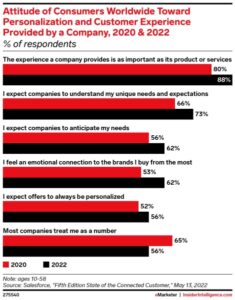
Stop treating your ideal customers as a number. This means your traditional squeeze pages and non-personalized landing pages are least likely to work.
Here is what you should do to improve personalization and how to use it to generate business leads:
- Create buyer personas for your brand.
- Create an offer and content that’s relevant to the buyer persona you are targeting.
- Create multiple landing pages and squeeze pages for lead gen.
- A/B test your squeeze pages.
Track lead generation sources and segment your lists based on them.
Step 7: Use Responsive and Optimized Forms
The number of mobile users is increasing rapidly and the majority of people access the internet from their smartphones. There are 5.48 billion unique mobile phone subscribers in the world as of April 2023, which is 68.3% of the global population. By 2028, the total number of smartphone subscriptions worldwide is expected to reach 7.86 billion, according to Statista.
An average website receives more traffic from mobile devices than desktops. And imagine if your lead generation form does not load and work on mobile.
Your landing pages and forms should be optimized for mobile devices and must be responsive. Choose your email marketing software and landing page platform carefully. And create forms for mobile devices and then optimize them for desktops instead of doing otherwise.
The form is the most important part of generating business leads, and it should be no less than perfect.
Step 8: Leverage Automation
Lead generation has always been automated. You use an email marketing platform, create forms, collect email addresses, and nurture leads all with the same tool.
Artificial intelligence has added a lot more opportunities and touchpoints for generating leads that go beyond your email marketing or CRM tools.
Lead generation chatbots use AI to initiate conversations with your ideal customers. They offer personalized and real-time solutions to website visitors that help you generate leads for your business.
You can create a dedicated chatbot for your brand within a few minutes using templates and without any technical knowledge. Integrate it with your email marketing software and start nurturing leads.
Step 9: Create a Partnership Marketing Campaign
Whether it’s a podcast, webinar, or an influencer marketing campaign, collaborative marketing is one of the best ways to generate leads.
According to a Forrester report, partnerships exceed paid search as a growth channel where mature partnerships generate 28% of revenue for brands. Another study reported that 57% of businesses use partnerships for lead generation and customer acquisition.
Collaborative marketing campaigns should be a part of your lead generation strategy. Use co-marketing, cross-promotion, product bundling, and other techniques to generate qualified leads for your business.
Red Bull, for example, works extensively with its partners, and it has a dedicated partnership page where it defines partnership pillars:
You don’t have to run such huge partnership campaigns — start with one. Partner with the right brand, set clear partnership goals, and execute them for mutual benefit.
Step 10: Blog Posts with CTAs
Content is the most used form of lead generation, with 76% of content marketers utilizing it. Over 88% of B2B marketers use content to generate business leads.
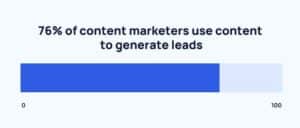
Blog posts are most effective in lead generation for the early stage, as reported by CMI, but most brands don’t use blog posts for lead generation.
Why?
Because they don’t use calls to action.
Creating content for blog posts should focus on serving your existing customers’ needs while catching the eye of new leads. But simply writing articles about your business isn’t enough.
The best lead-generating blogs must contain strong CTAs that offer gated content in exchange for the user’s data. Carefully crafted and positioned CTAs not only bring new leads; they also drive blog revenue.
But if your blog CTAs aren’t getting clicks, it might be because they aren’t optimized for lead gen. It all starts with placement, and the most effective CTAs are generally those that are positioned in the middle of your content.
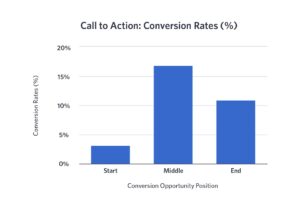
If you’ve been saving CTAs for the bitter end — stop. As a general rule, simple CTAs perform better near the top of your content, while complex CTAs are better off at the bottom. However, a middle-of-the-road form fill for lead gen is best suited for the first half of your content.
Bonus Step: Giveaway Campaigns
Giveaway campaigns on social media do wonders for lead generation. Not only do you generate leads, but giveaways boost your brand awareness significantly.
Giveaways and contests get massive engagement. On Instagram, giveaway posts receive 64x more comments and 3.5x more likes:
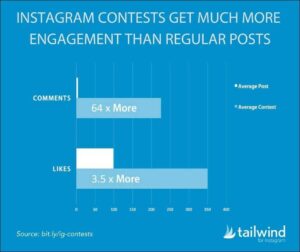
Since Instagram doesn’t allow external links (meaning lead generation gets difficult), it isn’t an ideal platform to run giveaway campaigns. As much as 92.6% of brands run giveaways on Facebook, and 20% of businesses use them for lead generation.
Here is an example of lead generation giveaway:
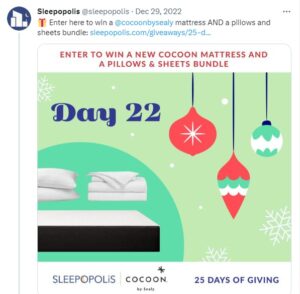
Instead of asking for likes, comments, and follows, they send traffic to a squeeze page to collect email addresses. That’s a perfect way to generate leads with a contest.
Remember, likes, comments, and shares are not equivalent to leads. Send traffic to your landing page.
According to the HubSpot State of Marketing Report 2021, generating more leads was the top marketing priority. Assuming it’s also your top priority when you wonder how to get leads for your business, you can use this step-by-step remedy to see real results and achieve your business goals.
Why Generating Inbound Leads Should be a Part of Every B2B Growth Strategy
Generating inbound leads should be critical to every B2B growth strategy. Here are a few reasons why:
1. B2B Buyers are Researching Products
Research shows that when considering a purchase, the average B2B buyer typically spends only 17% of their time interacting with potential suppliers. The rest of the time is spent researching.
This makes inbound marketing an essential ingredient of your growth strategy since it mostly relies on creating content fore search.
If your growth strategy doesn’t involve inbound lead generation tactics, then being discovered by B2B researchers will be next to impossible.
2. Cost-effective with High ROI
One of the primary reasons to prioritize inbound marketing in your growth strategy is that it’s cost-effective. This is because most inbound campaigns, like SEO, are some of the most affordable B2B marketing strategies.
In fact, research has shown that SEO is way cheaper than PPC, especially if you’re playing the long game.
And because inbound marketing is more cost-effective, it generates a higher ROI.
3. Offers Exceptional Personalization Opportunities
With competition for attention becoming stiffer on search engines, personalization has become a critical component of winning marketing strategies.
This is where inbound marketing comes to play.
Most inbound marketing strategies are designed with personalization in mind. Because of this, you can easily capture the right prospects at the right time and at the right stage of the customer journey. As a result, your campaigns will convert like gangbusters.
4. Improves Lead Quality & Win Rates
Because of the powerful personalization, the leads you get from inbound marketing are of a higher quality. In fact, 60% of marketers cite inbound marketing as their top source of high-quality leads.
And by virtue of designing your strategy around your sales cycle (ToFu, MoFu, and BoFu) you can easily weed out prospects that aren’t a perfect fit.
A huge result of driving high-quality leads to your site is high conversion rates and, ultimately, better win rates. It also results in shorter sales cycles, resulting in faster business growth.
3 Quick Tips For Generating More Inbound Leads
1. Have a Clear Call to Action
While inbound marketing content should not be aggressive or overly pushy, it is still important that each piece of content you create includes a clear call to action (CTA). A good CTA will encourage people to sign up for your email list and/or visit your website. CTAs can be an extremely useful way to get users to engage with your brand without being overly intrusive. Just make sure that you clearly convey the value consumers will receive from joining your email list, as they are unlikely to arbitrarily subscribe to your email list if they do not see a perceived benefit in doing so.
Inbound lead generation should be a critical component of your company’s marketing strategy in order to maximize your website’s conversion rates and build/maintain your customer base.
2. Get Listed In Industry Specific Business Directories
Another excellent way to generate inbound leads is to get your brand listed in industry-specific SaaS business directories.
FYI, SaaS business directories are online registries that list SaaS businesses in an index. The index is organized alphabetically by industry, location, or use case, among other factors. And the best part is that each business’s listing is linked to the company’s website.
The biggest advantages of getting listed on SaaS business directories include:
- Greater visibility: This is because they are visited by your target audience. They are usually a go-to resource for B2B buyers shopping around for a SaaS solution.
- Improved rankings: SaaS business directories are an excellent way of building relevant backlinks, resulting in higher domain authority (DA) and better rankings.
- Social proof: Getting listed on SaaS directories is a great way of gaining visitors’ trust. It’s a powerful form of social proof.
- Increased brand recognition and awareness: The more your target audience sees your brand on different platforms, the greater they become comfortable with it. This leads to an increase in trust, thereby boosting interaction with your brand. brand recognition. This alos
All the benefits of listing your brand on SaaS business directories result in one main advantage: inbound leads. Users who discover your brand on these platforms are highly likely to visit your website and convert into paying leads.
3. Co-Marketing
Co-marketing is another powerful strategy for generating inbound leads. Simply put, co-marketing is a marketing strategy that involves 2 or more businesses working together to promote each other’s services.
For this approach to work, the businesses involved must be complimentary. This means they must target the same audience but must not be in direct competition. Running campaigns with such businesses helps you leverage their audiences, thereby giving you greater reach.
Some simple examples of leveraging co-marketing include:
- Working with industry influencers or industry-relevant publications
- Getting featured on industry-relevant podcasts, webinars, conferences
- Guest post contributions or participating in roundup posts
- Getting featured on partner pages
Another powerful way of leveraging co-marketing is creating blog posts based on the jobs-to-be-done (JTBD) framework. You can then include partner brands in these. Alternatively, you can publish “best off” articles that feature your co-marketing partners.
This type of marketing is an excellent method of generating inbound leads as most of the leads that come through this channel will be quality leads.
What You’re ACTUALLY Doing Right & Wrong
Plenty of marketing articles focus on exposure, brand awareness, and outreach. But if you want to see real, honest-to-goodness growth, then you need to spend more time focusing on quality lead generation.
Even if you’re already working to generate new business leads, you might be making some critical mistakes without realizing it. To ensure you’re using your time as efficiently as possible and securing the best leads for your brand, learn about the dos and don’ts of lead generation and — most importantly — why they matter.
Lead Generation Dos
Let’s start out on a positive note: If you’re doing any of these things as part of your lead generation efforts, then you’re already doing something right.
Listening to Customer Feedback
Your brand is already successful to some degree, so it’s clear that the product or service you’re offering has value. But if you’re not continuously iterating in order to meet customers’ ever-evolving needs, then you won’t be getting nearly as many new business leads as you could be.
So, it’s essential to always listen to customer feedback and tweak your offerings accordingly. For instance, you could gauge customer sentiment via:
- Feedback surveys
- Reviews
- Social listening
- Customer service tickets
- The links that are clicked on most
For example, let’s say your Google Analytics reports reveal that a significant number of people are clicking on one of your brand’s articles concerning a specific pain point.
By tailoring your product or service to better address that pain point (and emphasizing it more in your content), you can generate a greater number of new business leads who are ready to make a purchase in order to solve their problem.
Creating Buyer Personas
Having a general idea of who you’re selling to is one thing, but having a detailed persona that encapsulates their personality, wants, and needs is another.
That’s where buyer personas come in: With the detail and focus a well-rounded buyer persona can provide, you can more effectively hone in people who are most likely to become new business leads.
Already using buyer personas, but looking for a way to improve them? HubSpot’s free templates, such as the one shown here, can help you identify new areas to expand upon:
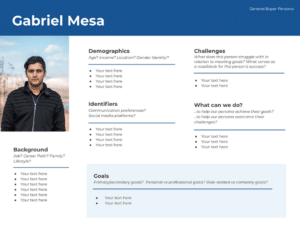
Investing in High-Quality Content
If you want to give potential customers the extra push they need to choose your brand over a competitor’s, then you need to devote time and money to high-quality content creation.
This can be more efficiently accomplished with a growth marketing content plan supported by well-defined goals, concrete data, and a solid content strategy.
But why does high-quality content matter so much? Simply put, because top-notch content tends to attract better-qualified leads. After all, someone who wants to read a well-written article addressing their unique needs is probably more prepared to convert than someone who simply wants to skim a fun listicle that’s relatively unrelated to your brand’s core offering.
Using a Robust CRM System
The term customer relationship management, or CRM for short, is fairly self-explanatory: It encompasses everything having to do with the relationships your brand shares with its customers.
CRM systems are the tools your brand can use to improve CRM, with some of the most widely used options being provided by HubSpot, Salesforce, and Zoho. Make sure the one you’re using includes intuitive features, such as:
- Support for the platforms and devices your team uses most
- Multichannel data collection
- Easily accessible analytics
- Campaign tracking
- Lead nurturing
With the right CRM system on your side, you’ll be able to generate, keep track of, and nurture leads throughout the entire funnel. In other words, you’ll not only be able to acquire more leads but also increase their chances of actually converting.
Lead Generation Don’ts
No lead generation strategy is 100 percent perfect, but there are some mistakes that are more common (and more damaging) than others. So when you’re striving to create new leads, you’d be wise to avoid any and all of these tactics.
Ignoring Audience Insights
Chances are that you have access to a hefty amount of data about your audience, whether it’s gathered from surveys, HTTP cookies, social media platforms, or any other source.
But if you’re ignoring the insights that data contains, then you’re leaving money on the table.
For example, perhaps your data reveals that a growing number of your site’s visitors belong to a younger-than-expected age group. If you fail to capitalize on that, then you risk losing a number of new business leads from an entirely fresh audience.
Valuing Quantity Over Quality
There’s no denying that search engines and social media networks alike value accounts that publish content on a regular basis. But that doesn’t mean you should stop investing in quality content in favor of publishing as much content as possible.
And if you are valuing quantity over quality, then there’s a good chance you’re pushing away new business leads who are more likely to be sold on stellar content and genuine value than on five new blog posts per day.
Neglecting Automation
With so many easy-to-use tools on the market, there’s no reason why you should rely on manual data entry and communications 100 percent of the time.
This is more liable to be the case if you have a sub-par CRM system, such as one that requires staff members to enter certain types of customer information by hand.
If you need to stop putting off automation and start generating new business leads, try implementing handy tools such as:
- HubSpot
- Reply.io
- OptinMonster
- Qualaroo
- Intercom
Failing to Cater to Mobile Users
If you’re still putting mobile-friendliness on the back burner, then it’s time to re-evaluate your priorities. After all, more than half of all web traffic is mobile as of Q1 2021:

Pair that with Google’s mobile-first indexing and you have one undeniable truth: A great deal of your potential customers are on mobile, and so are Google’s web crawlers. So if you want to capture as many new business leads as possible, then prioritizing mobile-friendliness is non-negotiable.
To get a clearer idea of where to start, try evaluating your site’s current mobile-friendliness with Google’s free test.
Overlooking CTAs
Remember that in order for a lead to convert — whether that means making a purchase or signing up for your newsletter — they need to take some sort of action.
To encourage them to do so, you need to master the art of calls to action (CTAs). So if it’s been a while since you’ve overhauled your brand’s CTAs and tested which are the most effective, it’s time to change that ASAP.
Even small changes can make a difference. For instance, Black & Decker discovered through A/B testing that a CTA button reading “Buy Now” was a whopping 17 percent more successful than one reading “Shop Now.”
At the end of the day, it’s most critical to remember that there’s no one-size-fits-all approach to lead gen. But as long as you keep evolving to meet the needs of your customers and show your brand in its best light, you’ll be well on your way to generating new business leads and securing more sales.


